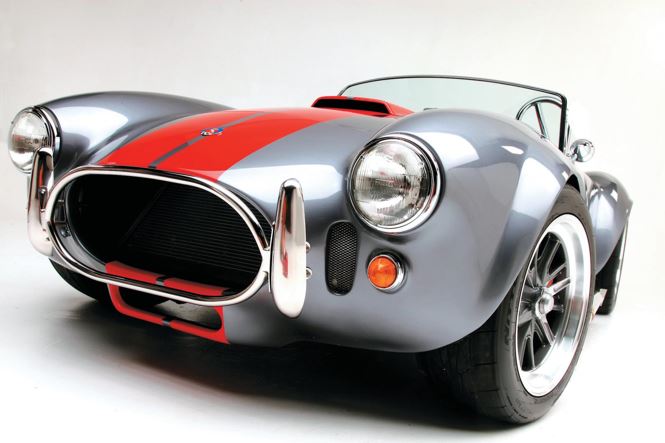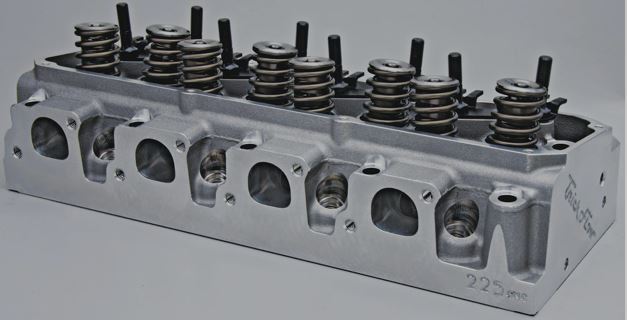
Q: I’m building a Factory Five Mk4 Roadster and I would love to install a Boss Nine 427 engine, but it’s way out of my budget.
Ford Performance offers a very attractive Windsor-based 427 crate engine, but that’s not exactly what I’m after. A nostalgic Ford engine is more appealing to me, and a friend of mine mentioned building a 427 Clevor—a Cleveland/Windsor hybrid. What can you tell me about this?
…
A: Before the advent of high-performance aftermarket cylinder heads for small block Ford, savvy hotrodders would retrofit the higher-flowing Cleveland cylinder heads onto their Windsor blocks along with Boss-style pistons.
The Cleveland’s canted valve angles point the valves toward the center of the cylinder, reducing the shrouding effect of the cylinder wall. This improves cylinder filling and overall power.
The Clevor is similar to the Boss 302. It consists of a Windsor block outfitted with Cleveland cylinder heads. It’s not limited to a particular displacement and can be built on a 302 or 351W platform.
Unlike the old days, many off-the-shelf components are available for the Clevor. The 427 will require an aftermarket block with a 4.125″ bore and a 4.00″ stroke crank. A stock block with a 4.040″ bore using a 4.170″ stroke can achieve the same displacement, but that combination pushes the limits of an acceptable rod angle.
The bore spacing (4.380″) and cylinder head bolt pattern of Windsor and Cleveland engines are the same, so the heads bolt right on. However, the engine’s coolant passages must be modified. Unique pistons are necessary to clear the canted valves and match the Windsor deck height. An aftermarket intake manifold is also needed.
For the cooling system to function properly, you must plug the water passages in the front and rear of each cylinder head’s deck because the ports do not properly align with the Windsor block. Three coolant holes (per side) must also be drilled into the block’s deck using a Boss-style head gasket as a template.
Depending on the intake manifold you use, coolant passages must either be drilled into the front of the cylinder heads or into the intake mounting surface.
Dry intakes (without a coolant passage) require a 1/2″ NPT hole in the front of the cylinder heads as well as installation of an aftermarket water crossover kit. A wet intake (coolant crossover in the front of the intake) requires coolant passage holes to be drilled into the intake face at the ends of the cylinder heads.
The Windsor piston’s inline valve reliefs are not in the correct location to provide proper piston-to-valve clearance, and its deck height is roughly .300″ taller than a Cleveland. Because of this, pistons with Cleveland-style valve reliefs and a Windsor compression height are required. This used to mean that custom-order pistons were needed, but because of the popularity of the Clevor, companies like Trick Flow Specialties now offer off-the-shelf pistons for the combination.
Trick Flow also offers performance aluminum Cleveland heads. They have taken Ford’s 2V (2-barrel) design and produced a lightweight cylinder head with ports large enough to flow generous amounts of air, yet sized correctly to deliver outstanding velocity. These heads are available in 190cc as-cast, and 195cc or 225cc CNC-machined intake volumes.
They come prepped to make the Clevor transformation easier, with coolant passages in the heads threaded to accept pipe plugs and pilot dimples for locating the correct drill points.

Trick Flow also manufactures carbureted and fuel-injected intake manifolds for 351-based Clevor combinations in operating ranges from 1,500-8,000 rpm. These intakes are dry and will require a water crossover kit.
With the ample availability of Windsor blocks, cranks, and camshafts mated to modern high-flow aluminum Cleveland heads, building a pump gas 427 Clevor engine that makes well over 600 horsepower with gobs of torque has never been easier. Use these links below to help get started in the right direction.
- Dart SHP Small Block Ford Cast Iron Bare Engine Block
- Eagle Forged 4340 Steel Crankshaft
- Eagle H-Beam Connecting Rods
- Trick Flow PowerPort Forged Pistons for Ford Clevor
- Trick Flow Track Max Hydraulic Roller Camshafts
- Ford 5.8L/351 Ford Cleveland Trick Flow Specialties Cylinder Heads
- Trick Flow Track Heat Intake Manifolds for Ford 351 Clevor
- Trick Flow® Clevor Water Crossover Kit

This appears sponsor-driven, because you failed to even mention Edelbrock has specific Clevor heads and intakes for both 302W & 351W block deck heights.
[…] Q: I’m building a Factory Five Mk4 Roadster and I would love to install a Boss Nine 427 engine, but it’s way out of my budget. Ford Performance offers a very […] Read full article at http://www.onallcylinders.com […]
This used to mean that custom-order pistons were needed, but because of the popularity of the Clevor, companies like Trick Flow Specialties now offer off-the-shelf pistons for the combination.
great information thanks for share it…
I have a 1970 Boss 302 Mustang I am rebuilding but availability of an original Boss 302 engine is out of my pricerange and they weren’t actually dependable for a lifetime of the car. So I am looking for an alternative engine Clevor sounds the best
Really informative article. thank for sharing
The post is really nice to read. I do appreciate it!
What about using a block from Australia?
You guys need to do more research. The guys that compete at Engine Masters have been building Clevor for years. Talk to John Kasse. He has won it a bunch of times. CHI from Australia (yeah I live there) has been doing for years as well. I agree with other comments. This is all sponsor driven.